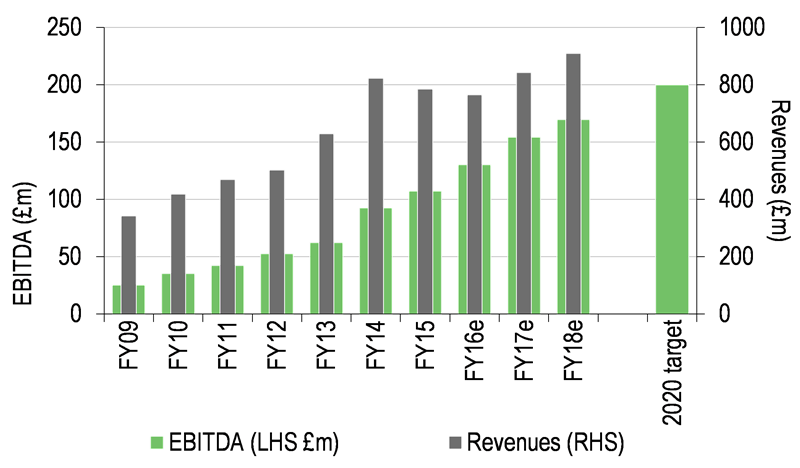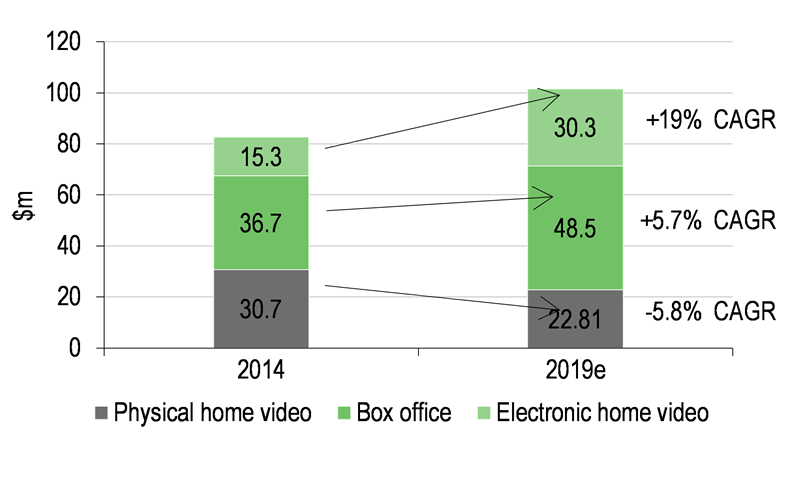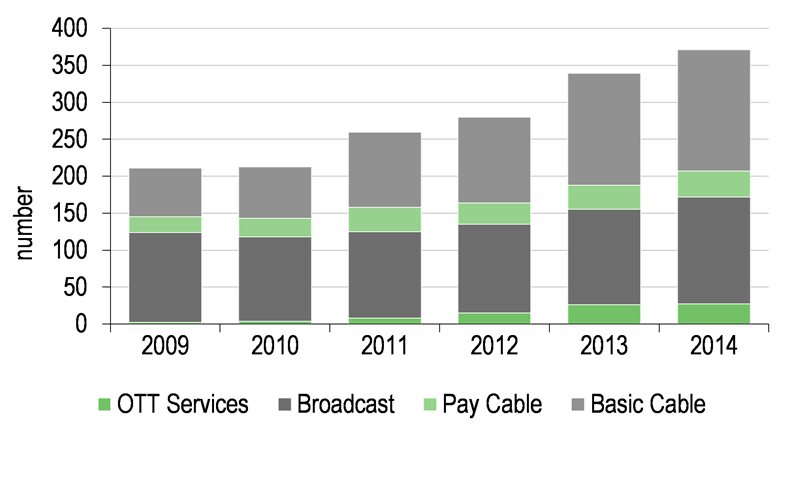eOne’s divisions – adapted to the new world order
eOne is well positioned in this evolving ecosystem. Its higher-growth and higher-margin Television and Family divisions now account for over one-third of revenues, but more than 60% of EBITDA (FY16e pro forma) and it recently reorganised its international sales division to bring its TV and Film sales under one umbrella to exploit synergies across its large and growing TV network. It has agreements in place with all the key digital channels: Netflix, Google, Amazon Prime, YouTube, Hulu, iTunes and blinkbox, and digital accounts for 23% of its revenues.
Exhibit 7: EBITDA contribution (FY16e pro forma)
|
Exhibit 8: Revenue mix by format (FY16e pro forma)
|
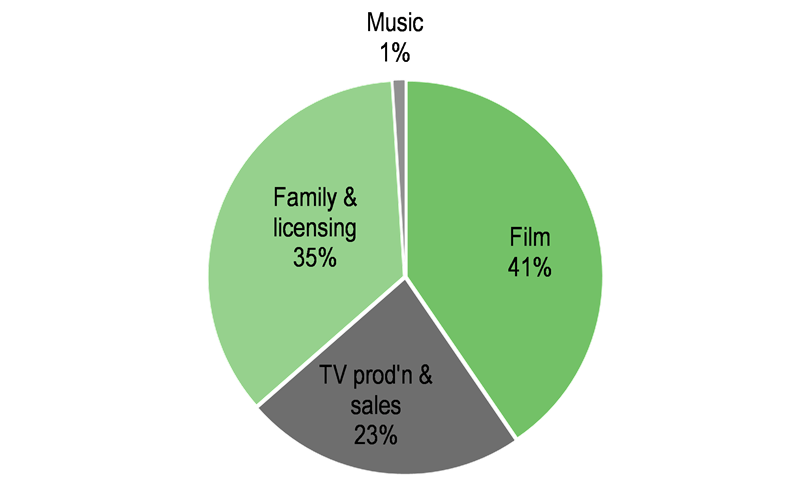
|
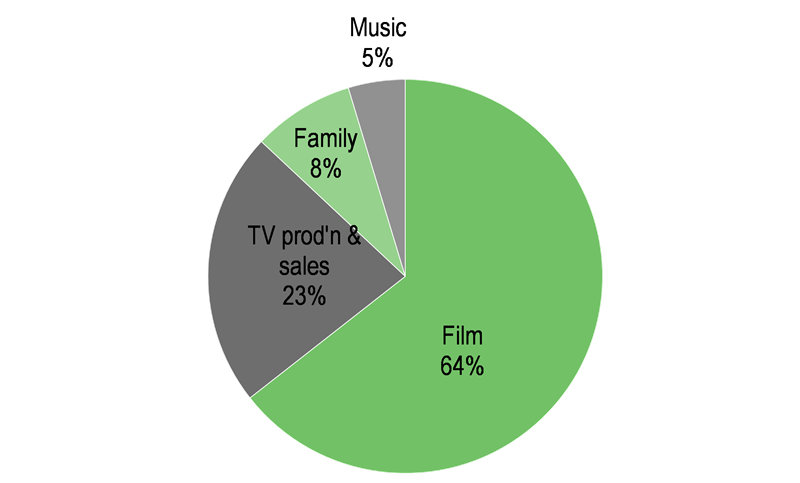
|
Source: Edison Investment Research
|
|
Exhibit 7: EBITDA contribution (FY16e pro forma)
|

|
Source: Edison Investment Research
|
Exhibit 8: Revenue mix by format (FY16e pro forma)
|

|
|
|
eOne Television (23% FY16 PF EBITDA): Partnering for sustainable growth
eOne has grown its TV operation to create a significant business in both production and sales. It is Canada’s largest TV producer and also has sizeable operations in the US through Mark Gordon (MGC). As well as developing its own content, eOne partners to secure access to third-party content for distribution. Important agreements include its output deal for all original scripted series with the fifth ranking US cable network AMC (to 2017), El Rey and Sundance, which provide a steady stream of content for international distribution, including recurring series such as The Walking Dead, Into the Badlands and Turn. This year it has also put in place first-look deals with producers Mark Ford and Kevin Lopez (Creature Films) and partnerships with award-winning producer Ilana Frank (ICF FILMS). Around half of eOne’s TV content is on seasonal renewals and its library of over 4,500 hours of TV content includes high-profile recurring titles such as Haven (in its sixth season on ABC), Saving Hope (season four), Coldwater Cowboys (season two) and Rookie Blue (sixth Season on ABC), which it sells to over 500 broadcasters in 180 markets.
Capitalising on a strong demand for television content, eOne is increasing investment in TV and this year is targeting over 1,000 half-hours of programmes (from 572 in FY15). It made two small acquisitions mid-2014 to strengthen its non-scripted entertainment: Paperny Entertainment Group for £15.1m and Force Four for £6m. However, the £86.3m acquisition of a 51% stake in MGC in December 2014, an LA-based production company with strong relationships in the US, represents a step change in the business’s development. The acquisition (which is now fully consolidated) has increased the pro forma EBITDA of the TV production and sales business by approximately two-thirds and has significantly improved eOne’s standing in the all-important US market as well as providing access to high-quality content from one of the industry’s most prolific producers.
In the past, MGC delivered production ideas (and rights over them) in return for ‘participation payments’ from its partner, ABC, which would then produce them. Moving forward, the new venture will continue to receive these payments. However, for new productions, it will move to a more classic model, where it produces its own ideas, which eOne will distribute (and monetise) via its international network. This enables a wider development remit (it is no longer restricted to ABC’s target audiences) and will add significantly more leverage for successful shows. To put this in context – the current formats developed by the MGC for ABC (including Grey’s Anatomy, Criminal Minds and Ray Donovan) are worth well over $1bn for ABC, yet we estimate MGC revenues of only $25m in FY14e. Mark Gordon is tied in for seven years and at eOne’s capital markets day (8 October) he shared some of his new ideas. He is currently developing 30 new projects – only a fraction of these will be ultimately be commissioned, but three have already received the green light by major US networks, to be broadcast next year.
Family (35% FY16 PF EBITDA): Globalising Peppa, developing new formats
The Family division creates, produces, distributes and licenses children’s programming and brands worldwide. Its cartoons are sold to over 500 broadcasters across 180 territories, creating and reinforcing the brands that generate licensing and merchandising royalties. These royalties generate the main profits of the division through the sale of a wide range of products including toys, books, bags, apps and DVDs. EBITDA margins are thus very high – 78% pro forma in H116. Its main asset is ‘Peppa Pig’, which we estimate accounts for c 85-90% of divisional revenues.
Peppa has had phenomenal success: over 200 five-minute programmes of Peppa have been produced since 2004, it is aired by 250 broadcasters and over 800 merchandising licences have been sold this year. Peppa is now the number one pre-school programme in the UK, Spain, Brazil and Mexico, and on the back of Peppa, Family division revenues have increased four-fold over the past four years. While the brand is maturing in some of its early markets, there remains plenty of scope to drive strong growth internationally. Exhibit 9 summarises Peppa’s current penetration and shows that in some of the largest toy markets in the world (US, China, Germany and Japan), its potential is only just starting to be tapped. Management believes Peppa can double retail sales to $2bn by 2020 (from $1bn in 2015, $250m five years ago).
Near term, we see the largest potential in the US where merchandising to date has been deliberately low-key to fully embed the brand. After four years in development, Peppa is now one of the top-rated children’s shows on Nick Jr, aired seven days a week in prime slots, and Forbes named Peppa as one of Google shopping’s top 10 children’s brands in 2014. With ‘pent-up’ demand for merchandise, eOne is ramping-up its US merchandising offerings through Toys R Us, Walmart, Amazon and Target this Christmas, and expects the US growth profile to follow that seen in the UK as the range of merchandise expands during 2016. In Germany and France, eOne plans to start a mass roll-out from spring 2016, while in China, TV broadcasts started on CCTV (state broadcaster) in June 2015, to be followed by a merchandising roll out through Toys R Us.
Exhibit 9: Peppa Pig – market growth potential
Market |
Market value potential |
Broadcast penetration |
Merchandise penetration |
Overall growth opportunity |
US |
$$$$$$ |
High |
Mid |
High |
Germany |
$$ |
Mid |
Low |
High |
China |
$$* |
Mid |
Low |
High |
France |
$$ |
High |
Low |
High |
Japan |
$$$ |
None |
None |
High |
UK |
$$$ |
High |
High |
Low |
Spain |
$ |
High |
High |
Low |
Italy |
$ |
High |
Mid |
Low |
Brazil |
$$ |
High |
High |
Low |
Source: Edison Investment Research. Note: *China is unclear due to the potential impact of counterfeiting.
To fully control the development of Peppa, in October eOne increased its stake in the rights from 50% to 85% via the acquisition of a further 35% stake from its partners ABD for £140.5m. In parallel, ABD has committed to produce a further 52 episodes. The acquisition gives eOne full control over brand development and monetisation, which will allow it to fully align its development with its strategy and other parts of the business, for instance by developing a Peppa Pig film.
In addition, eOne is developing some promising newer formats: it co-owns (with ABD) the rights to Ben and Holly‘s Little Kingdom, which has high ratings in the UK and is gaining traction in Spain, Italy, Germany and the US and where it is expanding merchandising this year to all markets. It has also recently launched PJ Masks (pre-school boys) on Disney Junior in the US, which delivered strong ratings and which will now be rolled out across the Disney Junior Network globally. It is also currently working on new series Winston Steinburger and Sir Dudley Ding Dong, co-produced with Teletoon Canada and ABC3 Australia for broadcast in Australia in January 2016.
Film (41% FY16 PF EBITDA): moving up the value chain
eOne Film is one of the industry’s largest independent multi-territory film distributors (‘indie’) with strong market positions in Canada (20% share of box office), the UK (10%), Spain (6%), Benelux (5%), and Australia, as well as distribution partners in France, Germany, Scandinavia, and South Africa. It also owns a sizeable physical distribution business in Canada and the US, and is moving up the value chain with a growing volume of sales and production.
eOne’s core markets cover 15-20% of the global box office. They are mature, but increasingly cash generative with the proportion of revenues derived from high-margin library titles increasing and content investment broadly matching amortisation. eOne’s strategy for growth is to shift upstream (more co-production and production), to control more content intellectual property and to develop new partnerships with creative talent (the ‘Hollywood Reporter’ recently suggested that it might take a stake in Stephen Spielberg’s DreamWorks Studios). It recently launched Momentum Pictures to distribute multi-platform content in the US and globally and it continues to explore acquisition opportunities to expand into new high-growth markets in Europe, Latin America and Asia.
eOne also owns a sizeable physical distribution business in Canada and the US, which handles its own content (film and television DVDs and Blu-ray), and provides distribution and internet fulfilment services for other entertainment companies. We estimate that eOne Distribution’s revenues make up about 25% of the Film division total. In Canada, eOne dominates the non-direct market (ie excluding the studios’ direct sales to major stores such as Walmart). The business is in managed decline due to the shrinking DVD market, but costs are strictly controlled and it remains cash generative. It also provides helpful market intelligence to the wider group.
Following the Alliance Film acquisition in January 2013, which brought key skills and relationships, eOne Features was established, which aims to produce four to six mid-budget ($10-15m) films a year. Being involved in a film’s creation at an earlier stage gives better access to content for more territories, and potentially higher margins. The risk around eOne Features is the same as for the rest of the distribution business as scripts are not ‘green-lit’ unless eOne film, on an arms-length basis, would be prepared to bid for the distribution rights across its five territories. The advantage to eOne is that if all five of its territories are prepared to offer a MG, it is strongly placed to negotiate a position as ‘executive producer’, which makes it an equity partner in a film giving greater exposure to any upside outside its own distribution markets. While this remains a small part of eOne’s overall portfolio of releases, with only a few films a year being production-financed (out of the total of c 210 releases in FY16), it has had notable success with the Insidious franchise. Releases over the last 12 months (Suite Française, The Woman in Black Angel of Death, Insidious: Chapter 3 and Sinister 2) have taken $181m at the global box office to date.
Music (1% FY16 EBITDA): small in the group context
eOne Music is one of the largest independent music labels in North America, covering a broad range of genres from gospel, R&B and contemporary Christian music to classical, rock and metal. It is fairly small in the group context, with estimated revenues of c £38m and EBITDA of £1.5m (both of which fluctuate slightly with the timing of releases). About 70% of sales are digital and despite the ongoing hiatus in the music industry, it has delivered a fairly stable underlying revenue stream over the last few years and is well-positioned in its market.




